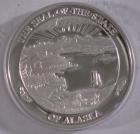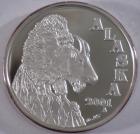2001 Alaska Medallion - The Mountain Goat


Total one ounce proof mintage: 7,213
Total Mintage Two Ounce Proof: 204
Current List Price $225.00
Our Price $175.00
Alan Holt of Soldotna, Alaska, designed the official 2001 Medallion.
Throughout the rough terrain of Northwestern North America and South Central Alaska, you will find the docile Mountain Goat. This mammal, with white hoofs and short black horns can be found near sea level to 10,000 ft. above. It is one of two all-white mammals in Alaska, often confused with young female Dall Sheep. Though characteristics in each animal are quite distinguishable, the mountain goats coat is longer, with hair up to 6 inches aligning spine, rump, chest and back of legs. Shaggy hair hangs from chin and along the jaw. Male Mountain Goats are bigger than females and female horns are the same length but more slender.
Their remote habitat, near steep, broken terrain protects them against predators, such as, bears and wolves. Life expectancy is 14 to 15 years, but most don't last 12. Scars, healed wounds and missing teeth are signs the animal's fight or may have fallen off cliffs. Kids are born to female goats every 180 days and remain with their mothers until the next breeding season. Only hours after birth the kids are able to keep up with adults.
Hemlock is the main diet source for the goats in the winter. Their diet mainly consists of lichens, moss and grass.
Silver Trivia
Silver is employed as a bactericide and algaecide in an ever-increasing number of water purification systems in hospitals, remote communities and, more recently, domestic households.
Silver ions have been used to purify drinking water and swimming pool water for generations. New research into silver compounds is providing physicians with powerful, clinically effective treatments against which bacteria cannot develop resistance.
An increasing trend is the millions of on-the-counter and under-the-counter water purifiers that are sold each year in the United States to rid drinking water of bacteria, chlorine, trihalomethanes, lead, particulates, and odor. Here silver is used to prevent the buildup of bacteria and algae in the filters. Of the billions of dollars spent yearly in the U.S. for drinking water purification systems, over half make advantageous use of the bactericidal properties of silver. New research has shown that the catalytic action of silver, in concert with oxygen, provides a powerful sanitizer, virtually eliminating the need for the use of corrosive chlorine.
Alaska Medallions are put in an "Airtite" high-density plastic capsule. While the capsule can be pried apart doing so endangers the proof condition of the medallion.
